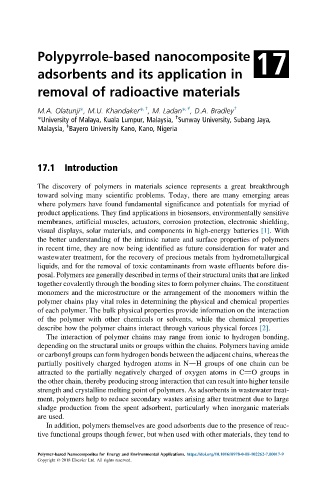Page 512 - Polymer-based Nanocomposites for Energy and Environmental Applications
P. 512
Polypyrrole-based nanocomposite 17
adsorbents and its application in
removal of radioactive materials
,‡
,†
M.A. Olatunji*, M.U. Khandaker* , M. Ladan* , D.A. Bradley †
†
*University of Malaya, Kuala Lumpur, Malaysia, Sunway University, Subang Jaya,
‡
Malaysia, Bayero University Kano, Kano, Nigeria
17.1 Introduction
The discovery of polymers in materials science represents a great breakthrough
toward solving many scientific problems. Today, there are many emerging areas
where polymers have found fundamental significance and potentials for myriad of
product applications. They find applications in biosensors, environmentally sensitive
membranes, artificial muscles, actuators, corrosion protection, electronic shielding,
visual displays, solar materials, and components in high-energy batteries [1]. With
the better understanding of the intrinsic nature and surface properties of polymers
in recent time, they are now being identified as future consideration for water and
wastewater treatment, for the recovery of precious metals from hydrometallurgical
liquids, and for the removal of toxic contaminants from waste effluents before dis-
posal. Polymers are generally described in terms of their structural units that are linked
together covalently through the bonding sites to form polymer chains. The constituent
monomers and the microstructure or the arrangement of the monomers within the
polymer chains play vital roles in determining the physical and chemical properties
of each polymer. The bulk physical properties provide information on the interaction
of the polymer with other chemicals or solvents, while the chemical properties
describe how the polymer chains interact through various physical forces [2].
The interaction of polymer chains may range from ionic to hydrogen bonding,
depending on the structural units or groups within the chains. Polymers having amide
or carbonyl groups can form hydrogen bonds between the adjacent chains, whereas the
partially positively charged hydrogen atoms in NdH groups of one chain can be
attracted to the partially negatively charged of oxygen atoms in C]O groups in
the other chain, thereby producing strong interaction that can result into higher tensile
strength and crystalline melting point of polymers. As adsorbents in wastewater treat-
ment, polymers help to reduce secondary wastes arising after treatment due to large
sludge production from the spent adsorbent, particularly when inorganic materials
are used.
In addition, polymers themselves are good adsorbents due to the presence of reac-
tive functional groups though fewer, but when used with other materials, they tend to
Polymer-based Nanocomposites for Energy and Environmental Applications. https://doi.org/10.1016/B978-0-08-102262-7.00017-9
Copyright © 2018 Elsevier Ltd. All rights reserved.

